First Official Kansas NANFA Chapter Collecting Trip
by Garold Sneegas
July 21, 1997
The first official collecting trip of the Kansas NANFA chapter was a great success. Participants were NANFA members Kate Shaw, Frank B. Cross, Steve G. Haslouer, and Garold W. Sneegas. Also along were Linda C. Fuselier, Josh F. Penrose, Emily C. Moriarty, and Pete B. Berendzen. The group sampled two collecting sites, one at Dragoon Creek, Osage Co., KS, the other at Mission creek, Wabaunsee Co., KS. Seventeen species were collected at each site for a combined total of 27 different species.
Steve Haslouer did an excellent job of scouting out the sites the week before and also checking the fish collection records at the University of Kansas Museum of Natural History. The last record found for Dragoon creek was from 1973. No records were found in the museum's collection from Mission creek.
We used several different seines from small ten foot seines for riffle sets, up to a thirty foot seine for the larger pools. I also used a dip net to access sites underneath cut banks and around log jams. We preserved a few specimens of each species for the museum's collection. During the sampling a number of male species were discovered in very impressive breeding colors. The most brilliant were Red shiners, Redfin shiners, Orangespotted sunfish, Slenderhead darters and best of all the discovery of brilliantly colored breeding male Topeka shiners in Mission creek. Everyone was exited by the fact that we could not find any records of the Topeka shiner in this drainage. Kate Shaw later discovered that Chris Mammoliti, a biologist with Kansas Wildlife & Parks, had in fact sampled the same site earlier and found a few Topeka shiners but no males in breeding condition.
It should be noted that Kate Shaw and Steve Haslouer both have Scientific Collecting Permits. If you do not have a Scientific Collecting Permit you can only collect fish under legal bait collecting methods which limits seines to 15 feet long and four feet deep with a mesh size no larger than one-fourth inch. Other bait collecting methods include fish traps, fishing line, dip nets and cast nets all of which have certain restrictions. If you are going to collect in Kansas be sure to check the bait fish collecting laws.
Since I am still a little gimpy wading through rocky creek bottoms, I spent most of my time dip netting around odd little holes and underneath cut banks. Kate and Linda jump right in and left everyone in the wake of the seine as they terrorized the inhabitants of the deeper pools and riffles. Steve, Pete and Emily added efficiency to the seining by freeing the lead line of obstructions, rocks, tree limbs, etc., and kicking up rocks on the riffle sets.
Josh (age 10) was ready to help with any task asked of him especially kicking rocks and finding the deeper pools. By the end of the day he was missing one tennis shoe a hazard often encountered in muddy sections of Kansas creek bottoms He was excited about all the fishes sampled and is already on his way to becoming a reliable fish ID'er.
Frank was the official photographer and final judge on questionable fish identification however his official title did not prevent him from getting his feet wet on occasion.
On the way back from the expedition Kate, Linda, Josh, Frank and I stopped by Dr. Richard C. Robins home to look at the latest addition to his menagerie, a 3 week old burro plus a dip in his pool. Even though the temperature was in the upper 90's it was pleasant in the shade by the pool. While relaxing by the pool I listened to an interesting discussion between Frank and Richard. They were commenting on the research done by early pioneers of ichthyology from the late 1800's to the present.
The Kansas chapter is looking into several possible sites for the next collecting trip. The site will be somewhere in the "Flint Hills". More information will become available in the near future.
Collections
Site #1 Dragoon Creek
Dragoon creek flows into Pomona Reservoir. The reservoir was built by the Corps of Engineers on the Maras Des Cyne river. The site we were at was just inside the Corps of Engineers high pool boundary. The gravel access road to the site we visited merged onto a large limestone shelve which we where able to drive along to edge of the creek. This site is a popular site for anglers in early spring when White bass from the reservoir migrate upstream to spawn. There is a large pool next the limestone created from the ledge itself and the abutments of an abandoned bridge upstream. The bottom of the pool consisted of parts of the flat limestone ledge, loose rocks, gravel, some mud and silt. Downstream there were smaller pools and riffles. Their bottom structure was similar to the large pool minus the solid limestone shelve. The creek was partially shaded tree lined banks.
Species collected from Dragoon creek:
Gizzard Shad, Dorosoma cepedianum
Red Shiner, Cyprinella lutrensis
Redfin Shiner, Lythrurus umbratilis
Sand Shiner, Notropis ludibundus
Central Stoneroller, Campostoma anomalum
Bluntnose Minnow, Pimephales notatus
River Carpsucker, Carpriodes carpio
Stonecat, Noturus flavus
Slender Madtom, Noturus exilis
Channel Catfish, Ictalurus punctatus
Orangespotted Sunfish, Lepomis humilis
Bluegill, Lepomis macrochirus
Green Sunfish, Lepomis cyanellus
Largemouth Bass, Micropterus salmoides
White Crappie, Pomoxis annularis
Logperch, Percina carprodes
Slenderhead Darter, Percina phoxocephala
Site #2
Mission Creek
Contrary to popular belief Kansas is not all flat. The site we visited at Mission Creek was in a small park with the main attraction being a towering rock cliff cut by the creek. It was difficult to seine below the cliff because of the large rocks and boulders deposited from the cliff. The rest of the creek consisted of large pools and riffles with a mixture of rock, gravel, sand and mud bottoms. Mission creek was also partially shaded by tree lined banks.
Species collected from Mission creek:
Red Shiner, Cyprinella lutrensis
Redfin Shiner, Lythrurus umbratilis
Fathead Minnow, Pimephales promelas
Central Stoneroller, Campostoma anomalum
Bluntnose Minnow, Pimephales notatus
Topeka Shiner, Notropis topeka
Suckermouth Minnow, Phenacobius mirabilis
Creek Chub, Semotilus atromaculatus
White Sucker, Catostomus commersonii
Golden Redhorse, Moxostoma erythrurum
Slender Madtom, Noturus exilis
Orangespotted Sunfish, Lepomis humilis
Longear Sunfish, Lepomis megalotis
Green Sunfish, Lepomis cyanellus
Largemouth Bass, Micropterus salmoides
Johnny Darter, Etheostoma nigrum
Orangethroat Darter, Etheostoma spectabile
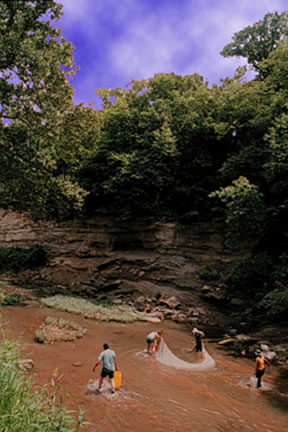
This view of Mission creek is just downstream where the Topeka Shiners, Notropis topeka, were discovered. Left to right, Garold W. Sneegas, Kate Shaw, Steve G. Haslouer, and Linda C. Fuselier. Photo by Frank B. Cross.
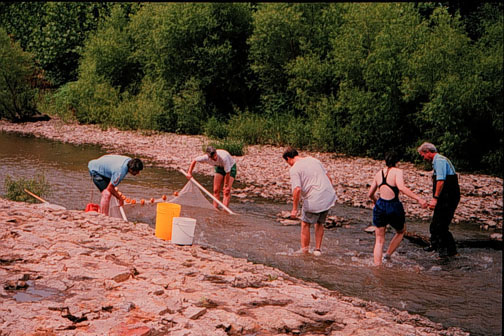
Garold Sneegas and Kate Shaw are holding the seine while Pete Berendzen, Emily C. Moriarty, and Steve Haslour move towards them kicking up rocks through the riffles. Several Slenderhead Darters, Percina phoxocephala, where found at this site. Photo by Frank B. Cross
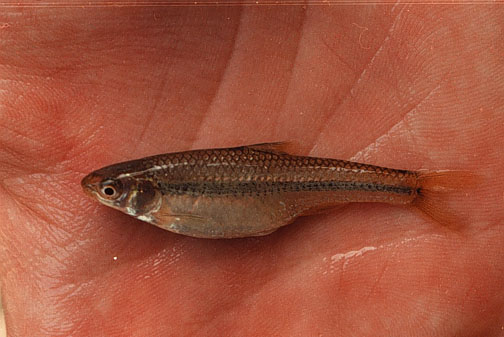
Female Topeka Shiner, Notropis topeka, from Mission creek. Photo by Frank B. Cross.
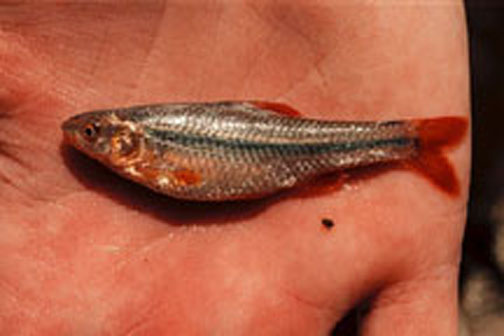
Male Topeka Shiner, Notropis topeka, from Mission creek. Photo by Frank B. Cross.
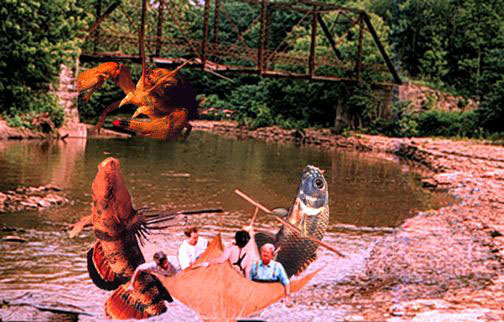
Catch of the Day